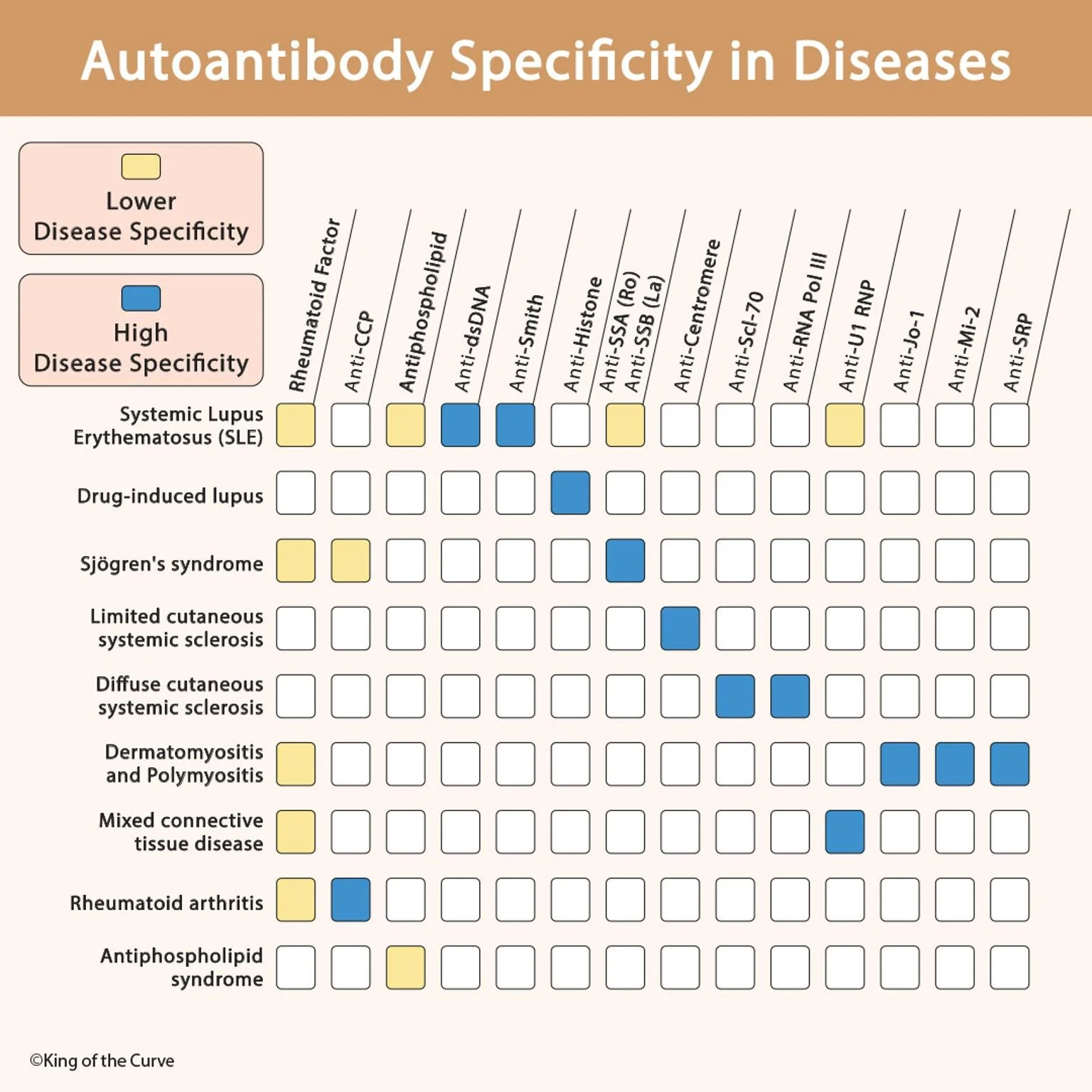🔬 Autoantibody Specificity in Diseases: A Visual Guide
Understanding autoimmune diseases often begins with decoding the autoantibodies associated with them. These disease-specific markers are powerful tools that help in diagnosing, classifying, and predicting various autoimmune conditions. The chart titled "Autoantibody Specificity in Diseases" offers a clear and organized view of which antibodies are associated with which diseases—and their degree of specificity.
🧩 What Are Autoantibodies?
Autoantibodies are immune proteins that mistakenly target and react with a person’s own tissues or organs. Their presence can be a hallmark of autoimmune diseases, and their detection plays a critical role in clinical diagnostics.
High specificity (🔵 blue squares): Strongly associated with a specific disease.
Lower specificity (🟡 yellow squares): May appear in multiple conditions, less diagnostic power alone.
🧠 Disease Breakdown by Autoantibodies
✅ Systemic Lupus Erythematosus (SLE)
High specificity: Anti-dsDNA, Anti-Smith
Lower specificity: Rheumatoid Factor, Anti-Phospholipid, Anti-Histone, Anti-SSA, Anti-SSB
These autoantibodies help differentiate SLE from similar conditions. Anti-dsDNA and Anti-Smith are highly specific and considered diagnostic hallmarks.
💊 Drug-Induced Lupus
High specificity: Anti-Histone
This form of lupus is usually reversible and linked with medications. Anti-Histone antibodies help confirm the diagnosis.
😔 Sjögren's Syndrome
High specificity: Anti-SSA (Ro), Anti-SSB (La)
Lower specificity: Rheumatoid Factor
Sjögren’s primarily affects the salivary and tear glands, and these markers are crucial for early detection.
🖐️ Limited Cutaneous Systemic Sclerosis
High specificity: Anti-Centromere
Associated with CREST syndrome, this autoantibody pattern helps clinicians pinpoint the disease subtype.
💠 Diffuse Cutaneous Systemic Sclerosis
High specificity: Anti-Scl-70, Anti-RNA Polymerase III
Indicates more severe systemic sclerosis with potential internal organ involvement.
🧬 Dermatomyositis and Polymyositis
High specificity: Anti-Mi-2, Anti-Jo-1, Anti-SRP
Muscle weakness and skin changes are typical in these myopathies. Each antibody can correspond to distinct clinical presentations.
🧩 Mixed Connective Tissue Disease
High specificity: Anti-U1 RNP
This overlap syndrome has features of SLE, scleroderma, and polymyositis. Anti-U1 RNP is a defining biomarker.
🦴 Rheumatoid Arthritis
High specificity: Anti-CCP
Lower specificity: Rheumatoid Factor
Anti-CCP is more specific and has prognostic value for disease severity and joint damage.
⚠️ Antiphospholipid Syndrome
Lower specificity: Anti-Phospholipid
Often associated with blood clotting disorders and pregnancy complications. These antibodies are also seen in SLE.
🧠 Key Takeaways
Diagnostic Power: High-specificity autoantibodies help clinicians make precise diagnoses and tailor treatments.
Overlap & Differentiation: Some antibodies may appear in multiple diseases, which requires comprehensive clinical interpretation.
Monitoring & Prognosis: Antibody profiles are also used to track disease progression or response to treatment.
📊 Why This Chart Matters
This matrix-style diagram simplifies a complex landscape into a digestible and comparative format, making it valuable for:
- Medical students
- Clinicians
- Researchers
- Patients seeking to understand their diagnosis
🧭 Final Thoughts
In the realm of autoimmunity, serological testing is a cornerstone. This chart bridges the gap between clinical symptoms and laboratory diagnostics, empowering healthcare professionals and learners alike with clarity and confidence.
Frequently Asked Questions (FAQs)
-
Aim for 4-6 focused hours, ensuring you incorporate breaks to avoid burnout.
-
Practice mindfulness techniques, take practice exams under realistic conditions, and maintain a balanced lifestyle.
-
Set short-term goals, seek support from mentors, and reward yourself for small achievements.
-
Regular exercise improves focus, reduces stress, and enhances overall mental clarity.
-
KOTC offers personalized learning tools, gamification features, and adaptive question banks to help students stay on track without burnout.


